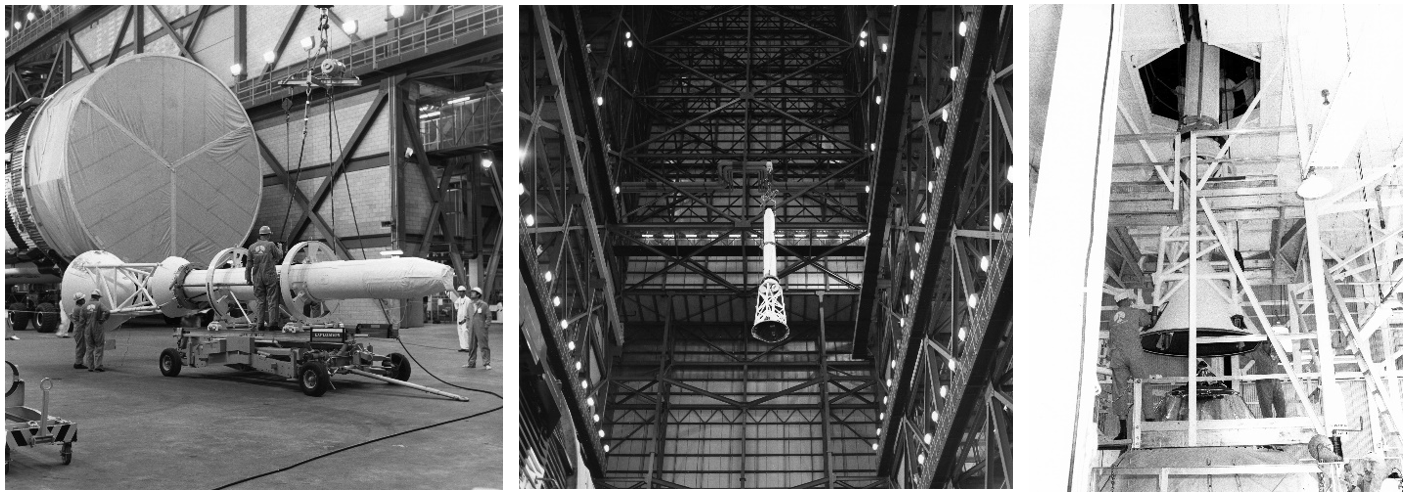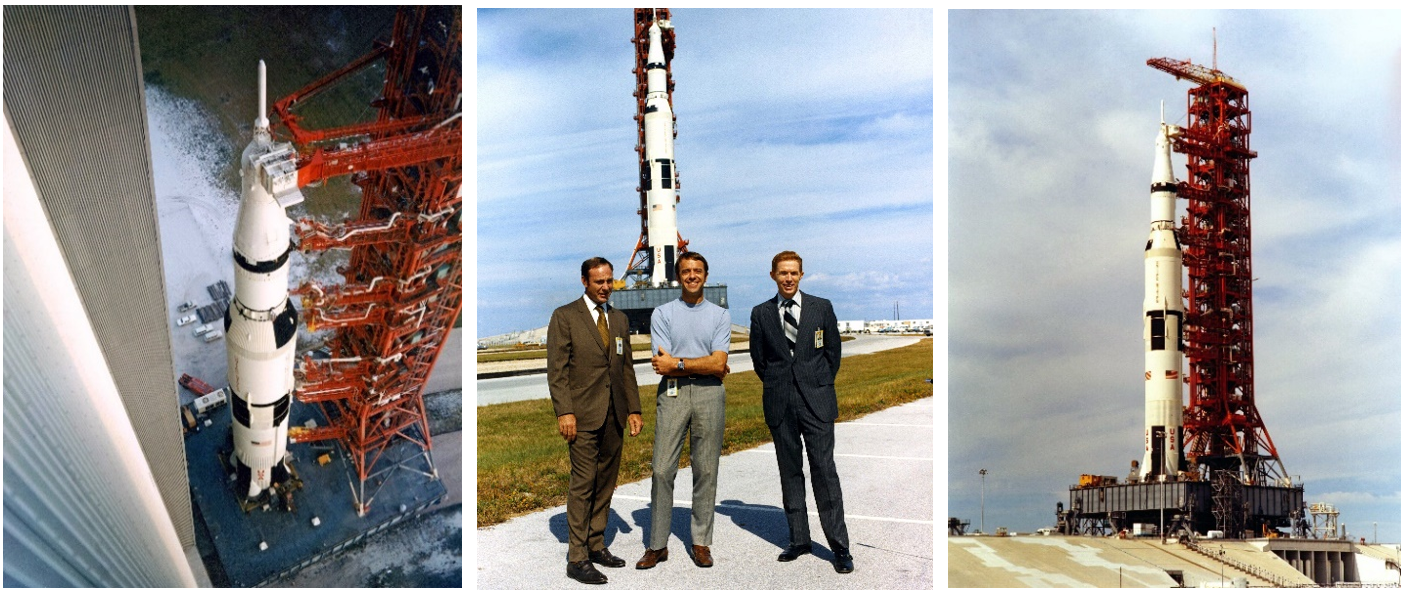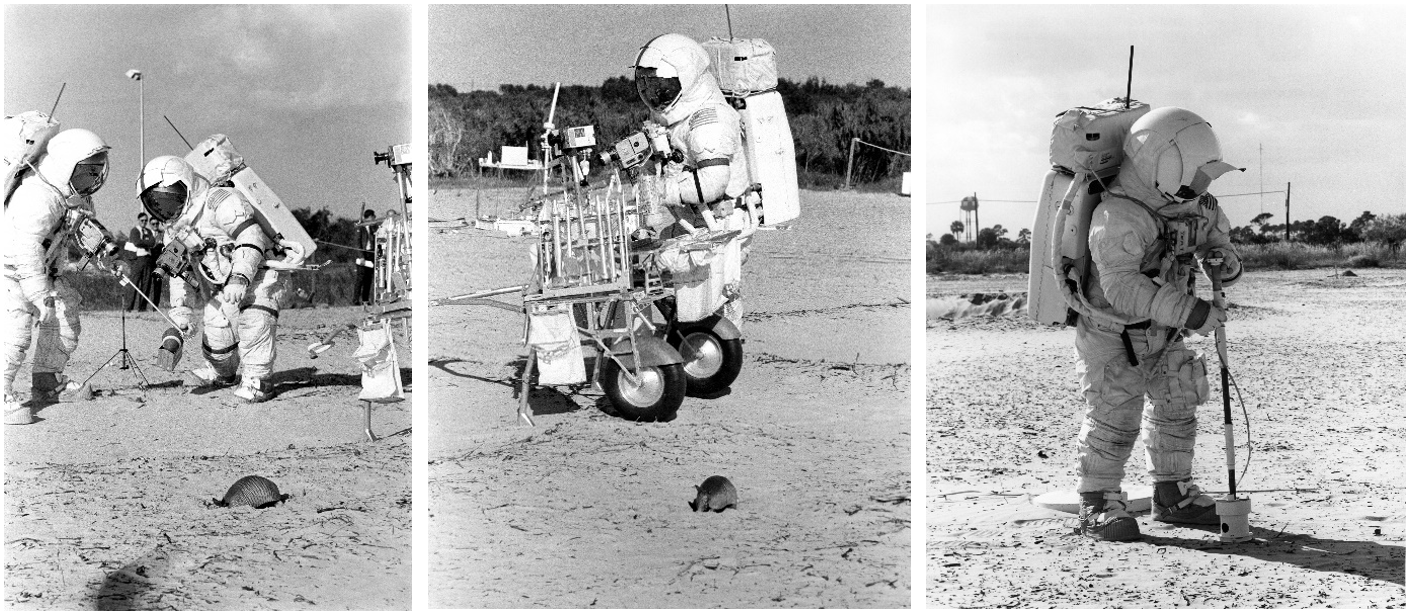50 Years Ago: Two Months Until Apollo 14
In November 1970, workers at NASA’s Kennedy Space Center put the finishing touches on the Saturn V rocket for the Apollo 14 Moon-landing mission before rolling it out to its seaside launch pad. The Apollo 14 crew of Commander Alan B. Shepard, Command Module Pilot Stuart A. Roosa, and Lunar Module Pilot Edgar D. Mitchell, along with backups Eugene A. Cernan, Ronald E. Evans, and Joe H. Engle, rehearsed aspects of their mission in spacecraft simulators. Shepard and Mitchell practiced their lunar surface excursions, planned for the Fra Mauro highlands, during a geology field trip to Arizona and several simulations at Kennedy. The Apollo 15 crew completed two geology field trips and received a training version of the lunar rover they planned to drive during their July 1971 Moon-landing mission to the Hadley-Apennine landing site.
 Left: Workers at NASA’s Kennedy Space Center prepare to lift the Launch Escape System (LES) tower to mount it atop the Apollo 14 Saturn V rocket. Middle: Workers lift the LES to place it atop the Apollo 14 Saturn V. Right: Workers lower the LES atop the Apollo 14 Command Module. Credits: NASA
Left: Workers at NASA’s Kennedy Space Center prepare to lift the Launch Escape System (LES) tower to mount it atop the Apollo 14 Saturn V rocket. Middle: Workers lift the LES to place it atop the Apollo 14 Saturn V. Right: Workers lower the LES atop the Apollo 14 Command Module. Credits: NASA
After stacking the Apollo 14 spacecraft atop its Saturn V rocket in the Vehicle Assembly Building (VAB), workers mounted the Launch Escape System (LES) tower atop the spacecraft on Nov. 8. The LES is used only in an emergency, during the first two minutes of powered flight, to lift the spacecraft and crew to safety should there be a serious malfunction with the rocket.
 Left: The Saturn V for the Apollo 14 mission exits the VAB as it begins its rollout to Launch Pad 39A. Middle: From left, Apollo 14 astronauts Edgar D. Mitchell, Alan B. Shepard, and Stuart A. Roosa pose in front of their Saturn V rocket as it rolls out to Launch Pad 39A. Right: The Apollo 14 Saturn V sits on the launch pad. Credits: NASA
Left: The Saturn V for the Apollo 14 mission exits the VAB as it begins its rollout to Launch Pad 39A. Middle: From left, Apollo 14 astronauts Edgar D. Mitchell, Alan B. Shepard, and Stuart A. Roosa pose in front of their Saturn V rocket as it rolls out to Launch Pad 39A. Right: The Apollo 14 Saturn V sits on the launch pad. Credits: NASA
The next morning, on the third anniversary of Apollo 4, the first flight of a Saturn V rocket, the Apollo 14 Saturn V began a slow roll out of the VAB, completing the 3.5-mile trip to Launch Pad 39A in about six hours. Shepard, Roosa, and Mitchell watched the rollout, even walking along with the rocket for a brief time. Roosa then answered reporters’ questions about the upcoming mission.
Once the rocket arrived at the pad, workers continued to prepare it and the spacecraft for the flight. They installed a spare battery and a third oxygen tank in the spacecraft’s Service Module, modifications resulting from the accident that crippled the Apollo 13 spacecraft on its way to the Moon in April 1970. They installed an accumulator device in the rocket’s second stage to prevent the pogo-effect vibrations experienced during the Apollo 13 launch, resulting in an early engine shutdown. In early December, engineers began spacecraft integrated systems testing, leading to the Flight Readiness Test planned for Dec. 17-18.
 Left: Apollo 14 astronauts Mitchell, left, and Shepard practice the second lunar excursion with the Modular Equipment Transporter (MET) in Cottonwood, Arizona. Middle: Mitchell, right, pulls the MET, aided by Shepard, during the Cottonwood geology field trip. Right: Shepard places a gnomon, a photography aid, during the field trip. Credits: NASA
Left: Apollo 14 astronauts Mitchell, left, and Shepard practice the second lunar excursion with the Modular Equipment Transporter (MET) in Cottonwood, Arizona. Middle: Mitchell, right, pulls the MET, aided by Shepard, during the Cottonwood geology field trip. Right: Shepard places a gnomon, a photography aid, during the field trip. Credits: NASA
Shepard and Mitchell, accompanied by a team of geologists, completed their final geology training field trip on Nov. 16 to the Black Mesa crater field near Cottonwood, Arizona. To make the terrain more lunar-like, workers blasted 14 new craters before the crew’s arrival, following erosion of earlier craters by heavy rains. Shepard and Mitchell completed their walking traverse while using the Modular Equipment Transporter (MET) to carry their tools and samples. They collected rock samples, including photographing and describing them, while in communication with mission control in Houston, where a science support team listened and analyzed the incoming information and advised the astronauts on further actions.
 Training for the first Apollo 14 lunar excursion. Left: Shepard trains to unfold the MET. Middle: Apollo 14 Lunar Module Pilot Mitchell practices removing the nuclear element from the Lunar Module before placing it into the radioactive thermal generator used to power the surface experiments package. Right: Shepard practices planting the American flag. Credits: NASA
Training for the first Apollo 14 lunar excursion. Left: Shepard trains to unfold the MET. Middle: Apollo 14 Lunar Module Pilot Mitchell practices removing the nuclear element from the Lunar Module before placing it into the radioactive thermal generator used to power the surface experiments package. Right: Shepard practices planting the American flag. Credits: NASA
Shepard and Mitchell, as well as backups Cernan and Engle, practiced for the two planned lunar surface spacewalks. During the first excursion, the astronauts planned to unfold the MET, stowed on the side of the LM, to help them carry their tools and collect samples. Other activities for the first spacewalk included setting up the suite of scientific experiments and deploying the American flag. The astronauts trained for these tasks in the Manned Spacecraft Operations Building (MSOB).
 Rehearsing the second Apollo 14 lunar surface spacewalk. Left: Mitchell, left, and Shepard practice collecting rock samples using a football as a stand-in, while an armadillo burrows into the ground. Middle: An armadillo observes Shepard retrieving tools from the MET. Right: Mitchell uses the “thumper” device to generate small seismic waves. Credits: NASA
Rehearsing the second Apollo 14 lunar surface spacewalk. Left: Mitchell, left, and Shepard practice collecting rock samples using a football as a stand-in, while an armadillo burrows into the ground. Middle: An armadillo observes Shepard retrieving tools from the MET. Right: Mitchell uses the “thumper” device to generate small seismic waves. Credits: NASA
The tasks for the second spacewalk involved longer traverses, aided by the MET, to collect the bulk of the geology samples. Using the “thumper” device, the astronauts caused minor seismic events that sensitive instruments recorded. The resulting data would inform scientists about the internal composition of the lunar crust.
Apollo 15
Preparations continued for the July 1971 Apollo 15 mission, the first with expanded capabilities, including a longer lunar surface stay time of three days and the use of the Lunar Roving Vehicle (LRV) to expand the range of astronauts’ geology excursions. The Grumman Aircraft Corporation delivered the two stages of the Lunar Module to Kennedy, with the ascent stage arriving Nov. 6 and the descent stage 10 days later. Workers in the MSOB began Lunar Module systems tests on Nov. 30. The Boeing Co. delivered the LRV 1-G trainer to NASA’s Marshall Space Flight Center on Nov. 17 for initial testing, following which, on Dec. 16, it was delivered to the Manned Spacecraft Center in Houston, now NASA’s Johnson Space Center, for astronaut training.
 Left: Apollo 15 Commander David R. Scott during the December 1970 geology field trip to Hawaii. Middle: James B. Irwin, left, and Scott refer to a checklist during a geology training traverse. Right: Irwin collects a soil sample during geology training. Credits: NASA
Left: Apollo 15 Commander David R. Scott during the December 1970 geology field trip to Hawaii. Middle: James B. Irwin, left, and Scott refer to a checklist during a geology training traverse. Right: Irwin collects a soil sample during geology training. Credits: NASA
The training for the Apollo 15 crew of Commander David R. Scott, Command Module Pilot Alfred M. Worden, and Lunar Module Pilot James B. Irwin, and backups Richard F. Gordon, Vance D. Brand, and Harrison H. “Jack” Schmitt, focused on the enhanced scientific aspects of the mission. The ambitious Hadley-Apennine landing zone, the first Apollo site away from the Moon’s equator, featured the 8,000-foot-high Apennine Mountains and the Hadley Rille, a 60-mile long, half-a-mile wide and 600-foot deep sinuous canyon. During a two-day geology field trip from Nov. 19-20 to the San Gabriel Mountains in California, Scott, Irwin, Gordon, and Schmitt used cameras and sample-collection equipment to practice collecting and photo documenting samples. A lengthier field trip to the islands of Hawaii and Oahu from Dec. 5-12 familiarized the crew with the geology of volcanic terrain. The astronauts used the Grover as a stand-in for the LRV during both trips to execute longer traverses than could be possible by walking.
To be continued …
World events in November and December 1970:
- Nov. 3 – Marxist Salvador Allende inaugurated as the President of Chile.
- Nov. 12 – Cleveland Cavaliers record their first NBA victory, defeating Portland 105-103.
- Nov. 17 – Soviet Luna 17 lands on the Moon and deploys the Lunokhod 1 rover.
- Nov. 17 – Computer scientist Douglas Engelbart receives patent for the first computer mouse.
- Nov. 20 – United Nations General Assembly accepts membership of the People’s Republic of China.
- Nov. 23 – George Harrison releases the single “My Sweet Lord” in the United States.
- Dec. 2 – Environmental Protection Agency begins operating.
- Dec. 15 – Soviet Venera 7 becomes the first spacecraft to soft land on Venus.
- Dec. 16 – Motion picture “Love Story” is released.
- Dec. 21 – President Richard M. Nixon meets with singer Elvis Presley in the White House; the image of the event is the most requested photograph from the National Archives.
- Dec. 31 – Paul McCartney files a lawsuit to dissolve The Beatles.







